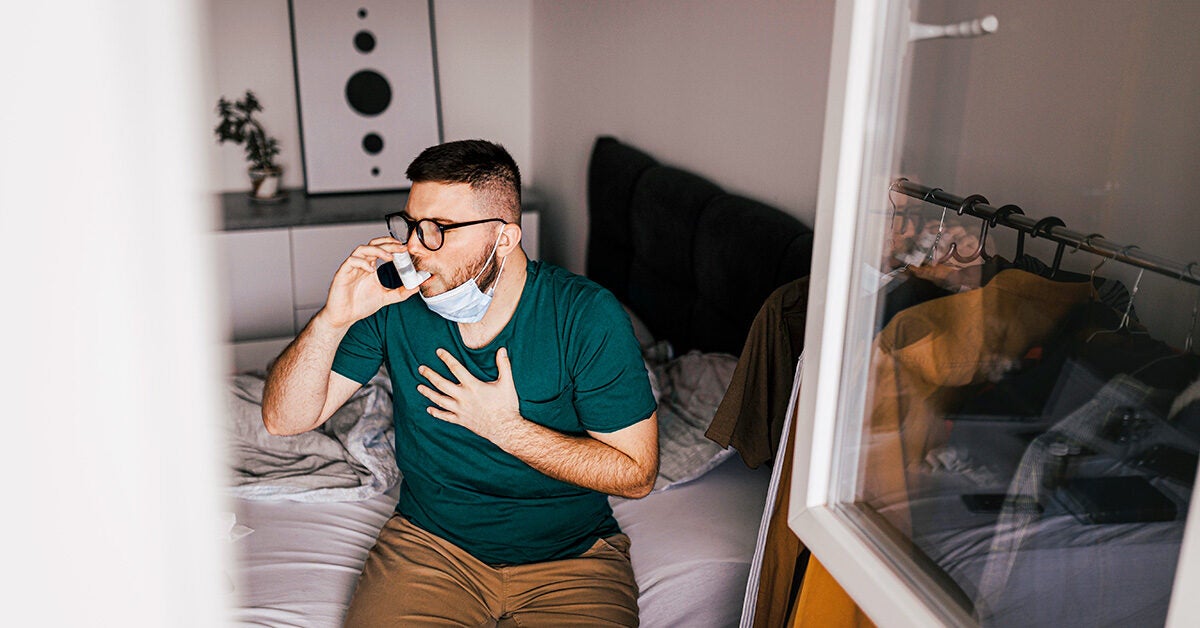
Asthma and anxiety are both considered chronic (long-term) conditions. Asthma involves inflammation and constriction of the airways, while anxiety disorders cause excessive worries and fears.
Anxiety is technically a mental health condition, but it often causes physical symptoms as well, including breathing difficulties. On the other hand, if you have asthma, it’s possible to experience anxiety about your ability to breathe normally.
In this article, we cover the symptoms of asthma and anxiety, including their key similarities and differences, and what you can do to help manage them both.
When you have asthma, your airways (bronchial tubes) can become inflamed. If you encounter triggers, such as allergens, exercise, or temperature changes, your airways become even more inflamed, making them tighten. This makes it hard to breathe, causing symptoms such as:
Asthma symptoms can also be worse at night, causing you to wake up frequently. Medications for asthma may also cause insomnia.
Anxiety, on the other hand, is a mental health condition. Unlike occasional worries or fears, an anxiety disorder may cause a wide range of physical symptoms as well.
There are several types of anxiety disorders. Generalized anxiety disorder (GAD) is the most common. With GAD, you may experience the following symptoms on most days for
- difficulty controlling fears and worries
- concentration difficulties
- restlessness and fatigue
insomnia
- irritability
- muscle tension
If you have an anxiety (or panic) attack, it’s also possible to experience breathing difficulties. Panic disorders
Below is a quick chart to help you determine the key similarities and differences between asthma and anxiety:
While asthma and anxiety are two separate conditions, it’s possible to have both at the same time. A flareup of one condition may also exacerbate the other.
Anxiety-induced asthma
There are numerous possible asthma triggers, including strong emotions such as stress and anxiety. Such strong emotions can change your breathing patterns — with or without asthma. You may even start experiencing faster breathing or breathlessness.
When you do have asthma, any worries, fears, or anger that may be associated with an anxiety attack could trigger breathing problems. You may find that calming breathing techniques, as well as anxiety treatments, could help improve your asthma symptoms over time.
How asthma induces anxiety
On the other hand, asthma may sometimes worsen anxiety symptoms. This may be especially true if you have severe, uncontrolled asthma that’s difficult to manage.
Severe asthma may significantly impact your quality of life. This can cause more anxiety over missing work, school, and regular activities. Such unpredictability in your asthma management may also lead to increased fears and worries over traveling too far from your home and medical equipment.
Additionally, research shows that some people living with asthma may experience limited coping strategies and unhelpful thinking patterns, which may induce anxiety symptoms. Managing mild and moderate asthma may also lead to better anxiety outcomes.
Without treatment and management, anxiety may lead to poor asthma control, and asthma may increase your symptoms of anxiety. It’s important to
Medical treatments for asthma and anxiety
Asthma and anxiety treatments involve different medications. Depending on your own situation, you may need multiple treatments to help you manage your condition(s).
Asthma may be treated with:
Anxiety
Other treatments
You shouldn’t replace any prescribed medications for alternative treatments, but certain complementary therapies can help you manage asthma and anxiety.
Breathing exercises are a mainstay of pulmonary rehabilitation techniques for lung diseases such as asthma. By retraining the way you breathe, you may be able to improve overall lung function and subsequent asthma symptoms.
The American Lung Association recommends practicing the following exercises each day, for 5 to 10 minutes at a time:
Belly/diaphragmatic breathing. With your hands on your stomach, breathe in and out through your nose. Feel how your stomach rises on the inhalation, and falls on each exhalation. Exhale up to two to three times longer than your inhalation. Keep your shoulders and neck relaxed during the process.
Pursed lip breathing. To complete this exercise, breathe in through your nose, and then exhale through your mouth, keeping your lips pursed. As with belly breathing, your exhalation should be at least two times longer than your inhalation.
Mindful breathing patterns may also help you see improvements in anxiety-induced asthma. If you feel anxiety or stress coming on, consider a 7-7-7 breathing technique, where you:
- Inhale for 7 counts (seconds).
- Hold your breath for 7 seconds.
- Exhale for another 7.
Regular exercise, rest, and a healthy diet may also improve anxiety-induced asthma.
Aerobic exercise
Asthma and anxiety are both common comorbidities, with each one potentially exacerbating the other. Still, it’s important to recognize the key differences between these two separate conditions for better management, and so you know when to get treatment.
Anxiety can lead to breathing difficulties, making your asthma symptoms worse. At the same time, uncontrolled asthma symptoms can increase stress about your ability to breathe, possibly leading to long-term anxiety.
If you suspect you have asthma, anxiety, or both, talk with your doctor about your symptoms and a treatment plan that may help you break the asthma-anxiety cycle.
Readmore : Dealing With Anxiety Attacks
Source: www.healthline.com
